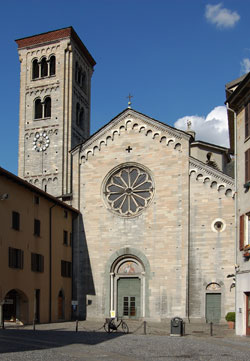
Feastday: October 28
Death: 304
A Roman soldier stationed in Milan, Italy. He aided Christian prisoners in an escape and was slain by his superiors. St. Charles Borromeo took Fidelis' relics to Milan, but some are venerated in Como.
Saint Fidelis of Como (Italian: San Fedele) (died c. 304) was an Italian soldier-saint, according to Christian tradition.
Legends
Fidelis' cult is associated with Carpophorus and Exanthus, two soldier-saints. Variations on their legend are applied to Fidelis. The first says that he, with Carpophorus and Exanthus, were Roman soldiers, members of the legendary Theban Legion, who deserted during the persecution of Christians by Maximian. They were caught and executed at Como. The second says that Fidelis was an army officer who was guarding Christian prisoners at Milan, including Saint Alexander of Bergamo. He managed to procure the freedom of five of these prisoners. With Carpophorus and Exanthus, he and these five attempted to make their way to the Alps, but were executed at Como. The martyrdom of Fidelis is considered to have occurred on the north side of Lake Como, near Samolaco.
Veneration
 The Basilica of San Fedele in Como.
The Basilica of San Fedele in Como.
The cult of Fidelis at Como is ancient. Magnus Felix Ennodius describes, in the early sixth century, a tomb at Como containing the relics of the martyr. Reports of miracles at the tomb fomented the popularity of his cult. Sometime before 1000, the church of Sanfedelino, which was dedicated to him, was built on the site of a much earlier simple chapel, which dates from around the fourth century.
Milan, Como, and Arona claim the relics of Fidelis.
Relics are said to have been transferred to Arona during a time of war between Milan and Como. In Arona, the presence of the relics of Fidelis and Carpophrous is attested in documents dating back to 1259 and 1321.
Como's claim is based on an account of 964 that describes the translation of Fidelis' relics from the spot where he was killed to Como in that year.
 The church of San Fedele in Milan.
The church of San Fedele in Milan.
In 1576, Charles Borromeo transferred to Milan relics of Carpophorus and Fidelis. Though until then their veneration in Arona was minimal, Borromeo's proposed transfer angered the people of the city. As a compromise, Borromeo brought back to Arona the two left forearms of the saints. This occurred on March 13. The city council, which had been pressured by the populace to bring back the relics, decreed that an annual festival occur on that day, which in succeeding centuries has increased in importance. The purpose of the festival was extended to include the celebration for the martyrs Felinus and Gratian, thereby uniting their cult to that of Carpophorus and Fidelis.
At Milan, Borromeo commissioned the church of San Fedele to Pellegrino Tibaldi (1559).
Notes
- ^ Alban Butler, revised by Peter Doyle, Butler’s Lives of the Saints (Liturgical Press, 1996), 196.
- ^ "Santi Graziano e Felino, Carpoforo e Fedele su santiebeati.it". Santiebeati.it. Retrieved 2020-08-28.
- ^ Alban Butler, Peter Doyle, Butler’s Lives of the Saints (Liturgical Press, 1996), 196.
- ^ Alban Butler, Peter Doyle, Butler’s Lives of the Saints (Liturgical Press, 1996), 197.





